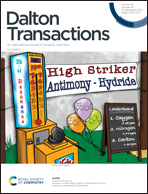A versatile nitrogen ligand for alkaline-earth chemistry†
Abstract
The tridentate ligand 1,8-bis-(2,6-diisopropylphenyl)imino-3,6-di-tert-butyl-carbazolate, {CarbDiPP}−, has been used to prepare a variety of complexes of the large alkaline earths (Ae) calcium, strontium and barium. A complex of their smaller congener, magnesium, has also been synthesised. The range of coligands that have been utilised include alkyls, amides, halides and tetrelides. All structurally characterised complexes presented herein are stable in solution and do not undergo ligand redistribution that is otherwise well-known to pollute the chemistry of the alkaline-earth metals. Detailed structural and spectroscopic data for these compounds are discussed. They provide compelling evidence that this nitrogen ligand allows for the kinetic stabilisation of Ae complexes through optimal steric encapsulation of the voluminous metal centres. Its ease of access combined to its evident versatility make {CarbDiPP}H stand out in the portfolio of proligands that have been devised for similar purposes in the past decade. Yet, it fell short in our attempts to synthesise heteroleptic Ae-hydrides upon action of PhSiH3 onto Ae-amides, as the crystallised products showed the imine groups were prone to hydride reduction and formal hydrosilylation.



 Please wait while we load your content...
Please wait while we load your content...